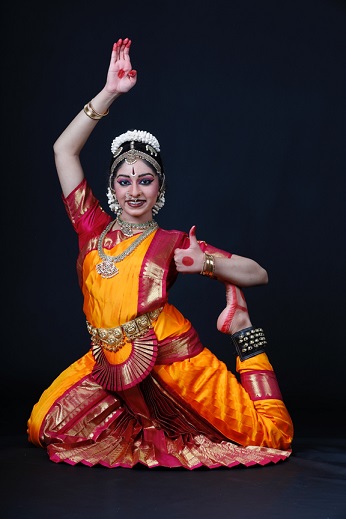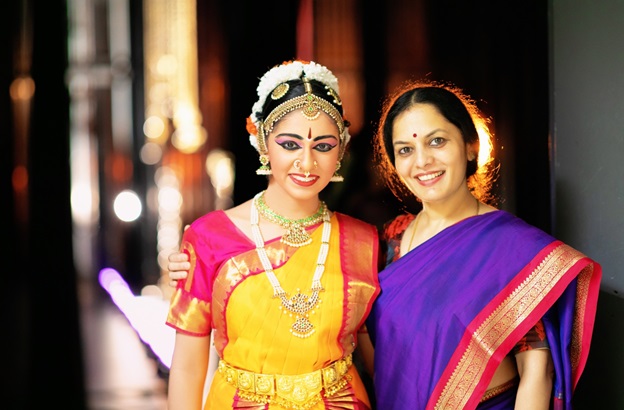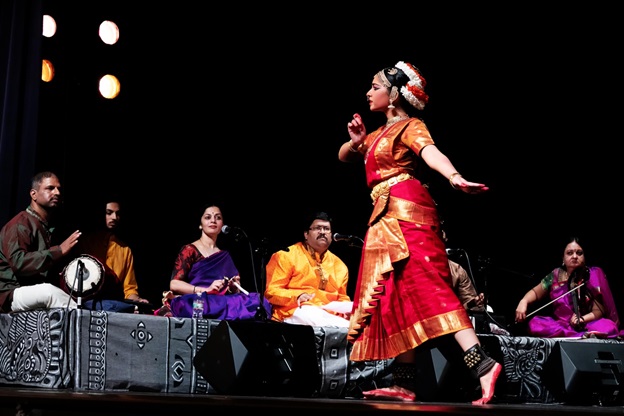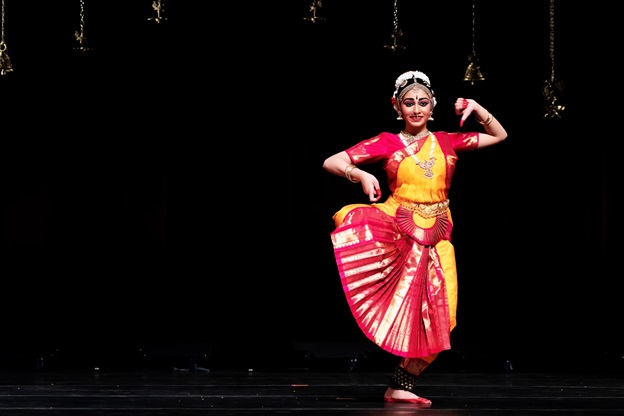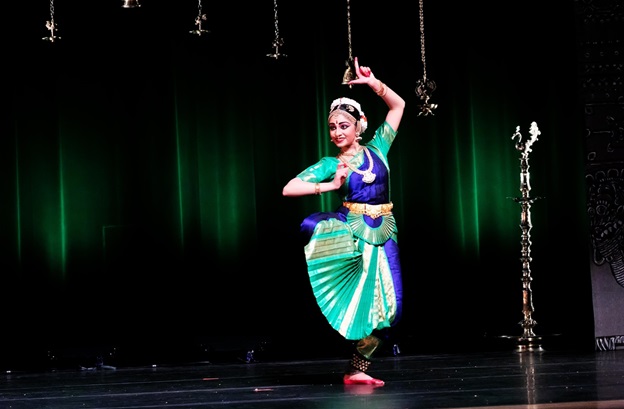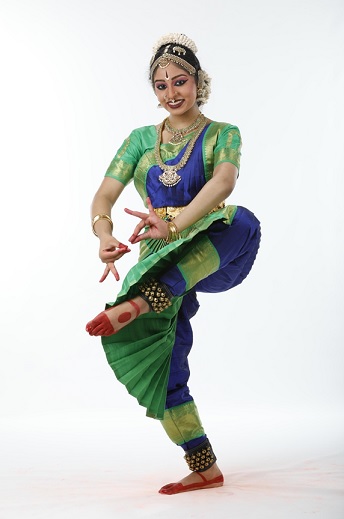Contribute
| Arangetram: Meera Ramesh |
Rajesh Vaidheeswarran
11/19/2018
I’ve known Meera for over eleven years now and always knew her as a happy, thoughtful, yet focused child. Her passion for the arts, be it Carnatic music or BharatanÄtyam (South Indian classical dance), shone through each time she has performed. So, it is with great delight that I write this review of her BharatanÄtyam arangÄ“tram (Tamil for “ascension to the stage†or debut solo performance) on Oct 20th 2018. BharatanÄtyam is one of the most ancient dance styles in the world, with its origins going back to the NÄtya ShÄstrÄs. The artform’s name itself is a combination of 4 words – BhÄva (expression), RÄga (musical scales), TÄla (rhythm) and NÄtyam (dance), and it is extremely precise and dynamic. Its technique rests on 3 pillars – Nritta (pure dance), Nritya (interpretational dance) and NÄtya (expressional dance). The body movements, intricate footwork and eloquent expressions are set to Carnatic music with themes depicting stories from Hindu purÄnas, itihÄsÄs (historical events) and mahÄkÄvyÄs (epics). BharatanÄtyam is a complete artform that combines artistic expression with spirituality. Meera started off with a customary PushpÄnjali, an offering of flowers and salutations to the Lord, her teacher and the audience, seeking their blessings for her performance. With the music being set to Amritavarshini rÄgam in Ädi tÄlam, it was a gracious and dynamic start to the arangÄ“tram. Meera followed it up with a delightful Ganesha Stuti (Vara Vallabha in Hamsadhvani rÄgam set to Ädi tÄlam). As I’ve seen Meera grow as a dancer, I’ve always noticed her very strong abhinayÄ (expressions) in group dances, but she shone bright in the well-lit stage as her expressions delivered the subtleties that her teacher Smt. Sridevi Thirumalai had intricately weaved into the nuanced choreography that we are all now accustomed to seeing on a regular basis from the Natyamani school of dance. Watching Sridevi and the kids dance is one of the definite perks of living in New England, despite its finicky weather and all! BhartanÄtyam is rich and variegated, and a good performance brings out the richness of the artform. Svara sollukattu is one such -- a pure dance presentation, in which intricate sequences (jatis) are fused with repetitive musical notes. The sollukattu specifically features svaras (musical notes) sung over the sollukattu (rhythmic syllables). This was in the beautiful TÅdi rÄgam set to rÅ«paka tÄlam, with VidvÄn Mattur Srinidhi’s voice singing the sollukattu, and Sridevi’s precise delivery of the jatis with the nattuvÄngam setting the beat for the dancer. What struck me most was how good Meera was at nritta! In a BharatanÄtyam performance, particularly, one with a live orchestra, a lot of things are happening at the same time. Flute and violin are setting the tone of the piece, mridangam and percussion instruments are setting not just the beat, but also creating a dynamic tempo based on the mood of the moment. A good performer on stage is taking it all in, but the one thing she is focused on is her teacher’s nattuvÄngam. You could hear Sridevi’s nattuvÄngam in Meera’s foot work. That was the connection between the guru and the shishya. The next piece brought a tear to many an observer. Parvati Nayakane in the versatile Shanmukhapriya rÄgam set to Ädi tÄlam is a composition of ultimate surrender to the Lord. In this composition, the composer surrenders to Lord Shiva, husband (NÄyaka) of Goddess Parvati. He pleads to the Lord to never forget him just as a mother never forgets her child. Sridevi’s choreography was so delicate and robust at the same time, and Meera’s delivery with her wonderful abhinaya interspersed with dynamic nÄtya could not but cause the audience to tear up. Meera displayed immense control and mastery over the abhinaya as she danced with one eye open, depicting the half-blind Kannapanayanar as he sacrificed his own vision to heal his bleeding lord. For many, that level of emotional depth and maturity is difficult to master, yet Meera executed it flawlessly (not to mention, with one eye closed!). Seeing her, I momentarily forgot that she was doing her debut solo performance. Varnam, meaning “color,†is the central and most elaborate piece of a Bharatanatyam performance. It integrates all aspects, showcasing the dancer’s expertise in both nritta (pure dance) and abhinaya (facial expressions). We had all come to glimpse at the various aspects of Meera as a dancer, but this would be the real test. This varnam, in ShankarÄbharanam rÄgam set to Ädi tÄlam, was in praise of Lord Vishnu, the all pervading protector of the universe. Meera, in her red and gold costume shone literally and figuratively all at the same time, pleading as the nayika to her sakhi (friend) to go and fetch her beloved, Lord Venkatesha of Tirupati. It was impressive to see Meera, at the beginning of the charanam, emote the line entirely with solely her eye movements before she did the line through nÄtya. The color (pun intended) added to the sancharis by the percussionists - Vidvan Srihari on the mridangam and Sudarshan on the rhythm pad - was subtle and understated and punctuated the sancharis beautifully. Sridevi’s ability is well-known and does not need much introduction as a choreographer. But, what must be mentioned here is her keen ability to know each and every student, their strengths, their weaknesses and helping them overcome the latter and shining as a star. This takes time, extraordinary commitment, a deep love for the art and a unique bond between the guru and the shishya. That bond was in full display in her intricate choreography that alternately moved Meera, a teen, from one difficult expression to another seamlessly. And Meera, to her credit delivered each of those sequences with poise, grace and fully in character that left the audience feeling the pang of the nayika’s separation from her Lord and with a lot of kleenex tissues to wipe their tears. Settling in after a few medhu vadas during the break, the audience was treated to the third part of Meera’s performance in her crisp blue and green costume. Meera began the second half of her program on a strong note, with the nritta-intensive, highly pleasing performance of Govindan Kuzhalosai (RÄgamÄlikÄ set to Ädi tÄlam). Her portrayal of the beauty and charm of the melodious flute of Lord Govinda was a delight to watch. As Lord Krishna, she brought out a certain playfulness and enacted the joy associated with being mesmerized by the music of Krishna in a very lively way. While we were treated once again to her abhinaya that did justice to the sweet nature of Lord Krishna, Meera also performed a long series of consecutive jathis, which were by no means a walk-in-the-park. Her amazing stamina did justice to Guru Sridevi’s lively nattuvangam, and the entire piece was a treat to watch. One of my favorite songs Sri Chakra Raja Simhasaneshvari (RÄgamÄlikÄ set to Ädi tÄlam) is on the universal mother. This song, popularly attributed to sage AgastyÄ, describes the mother in so many ways and how she gives knowledge and reveals the purpose of life to the composer. It was a feast for the eye to see the mother be portrayed in so many ways by Meera, moving from pose to pose as the singer described the mother’s various names. The gentle nature of the rÄgÄs in this piece was enhanced beautifully, as always by the amazing flutist Vidvan Narasimhamurthy and the precise melodies of Vidushi Tara’s violin. Meera again returned the audience to enjoying the playful imagery of the baby Krishna in the spritely DevarnÄmÄ (Yaman KalyÄni rÄgam set to Ädi tÄlam), describing Yashoda’s travails in having to bribe the toddler with goodies as he takes off with her churning rod. Her portrayal of motherly love and playful scolding was truly heartwarming to watch, and it had me humming the song long after her arangetram was over. The arangÄ“tram concluded with fast paced TillÄnÄ (Dhanashree in Ädi tÄlam) by the royal composer SvÄti TirunÄl in praise of Lord Padmanabha of Tiruvananthapuram. Meera wow-ed us all with an impressive series of kathak spins at the end of the piece, a feat only accomplishable with a high level of stamina, which she most definitely carried throughout her performance. Her TillÄnÄ was followed by an apt auspicious concluding piece, the mangalam, wherein the dancer thanks the Lord, her Guru, and all her well-wishers in the audience for supporting her through the successful completion of her ascension to the stage. Meera’s mangalam, which included verses from the Mahishasura Mardini Stotram, was a powerful conclusion to a brilliant performance as well as a fitting end to the holy Navaratri celebrations. We were filled to the brim with an amazing performance, but yet strangely left wanting for more. Like all things memorable that look so deceptively easy, it took years of hard work and perseverance of the young woman firstly, and ably supported by the amazing team work of the artists, Meera’s parents, the guru-shishya bond between Meera and Sridevi and a host of well wishers and community members in helping with the preparations for this grand event.
You may also access this article through our web-site http://www.lokvani.com/
